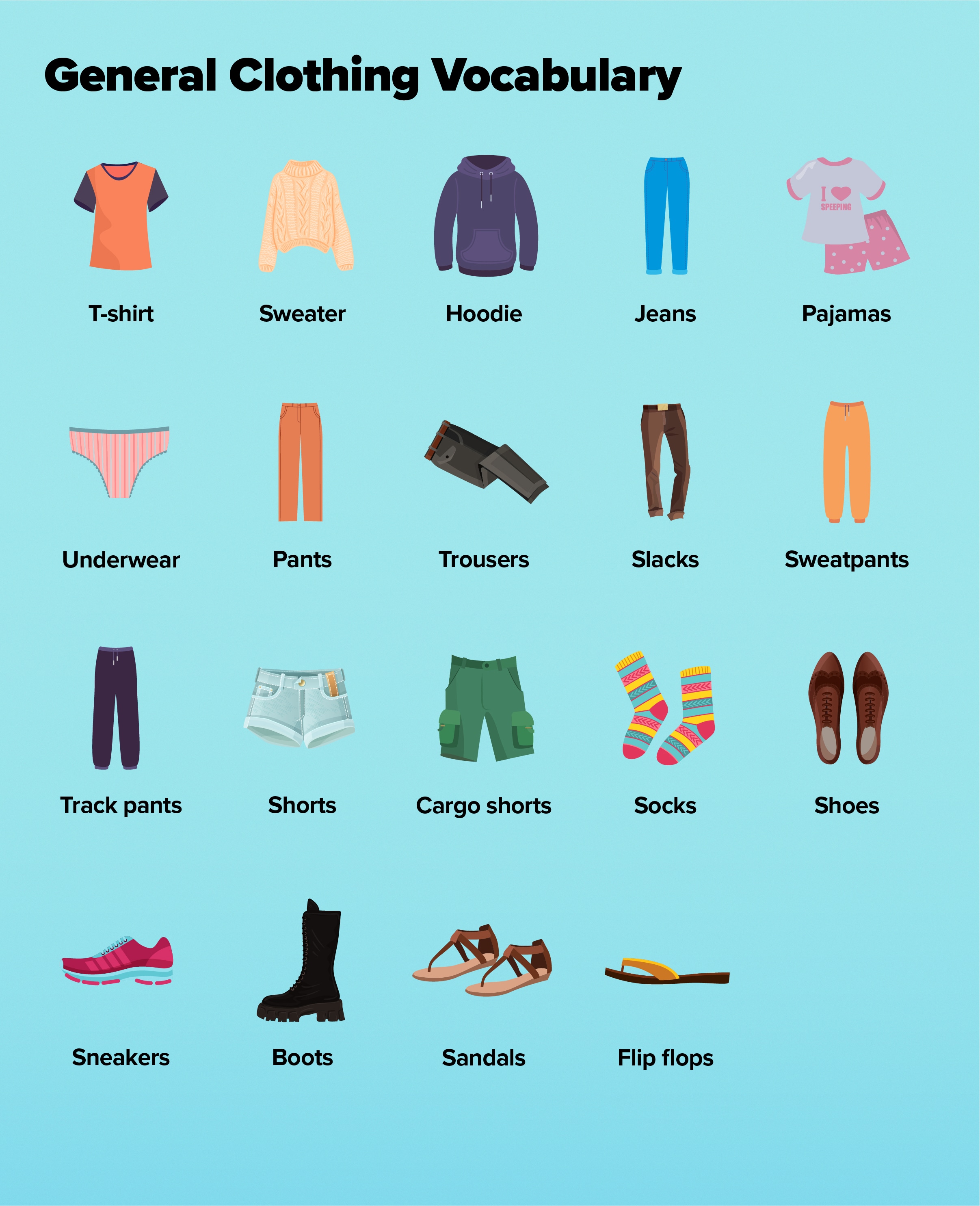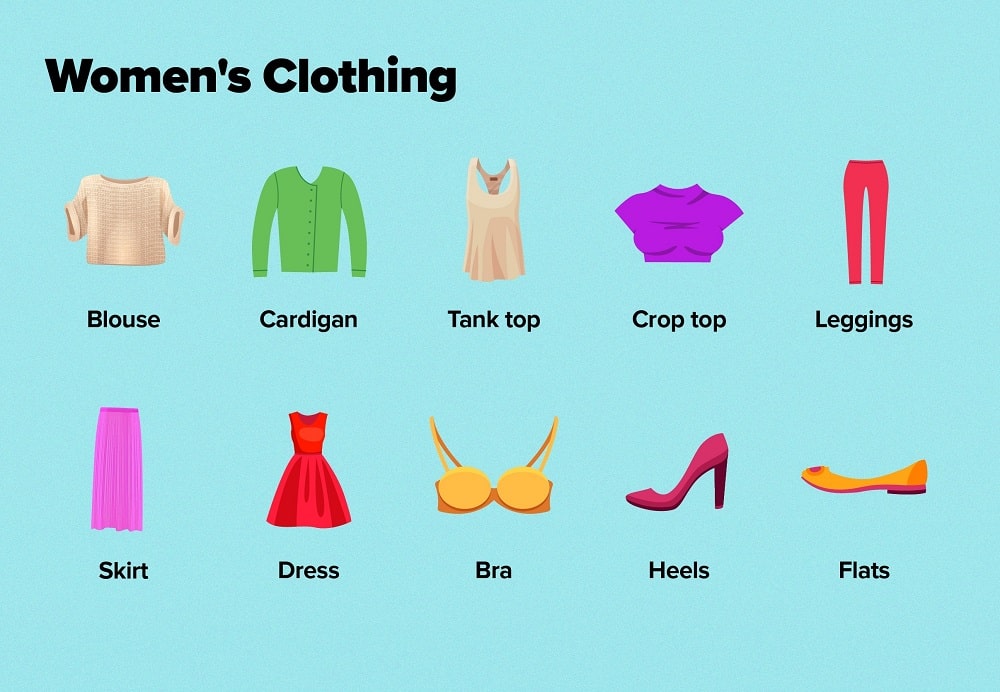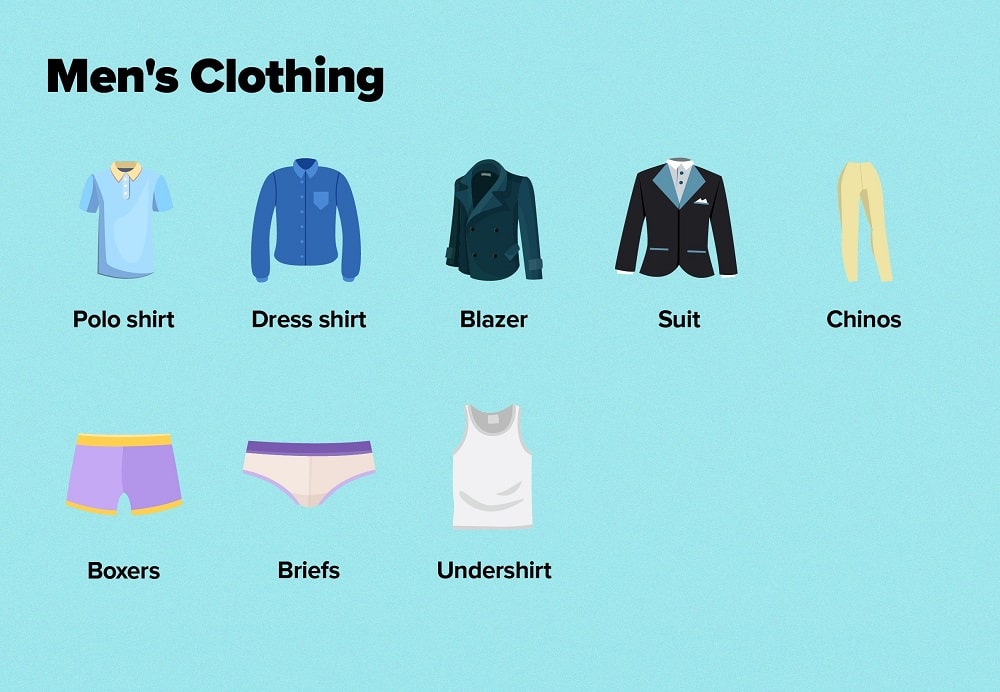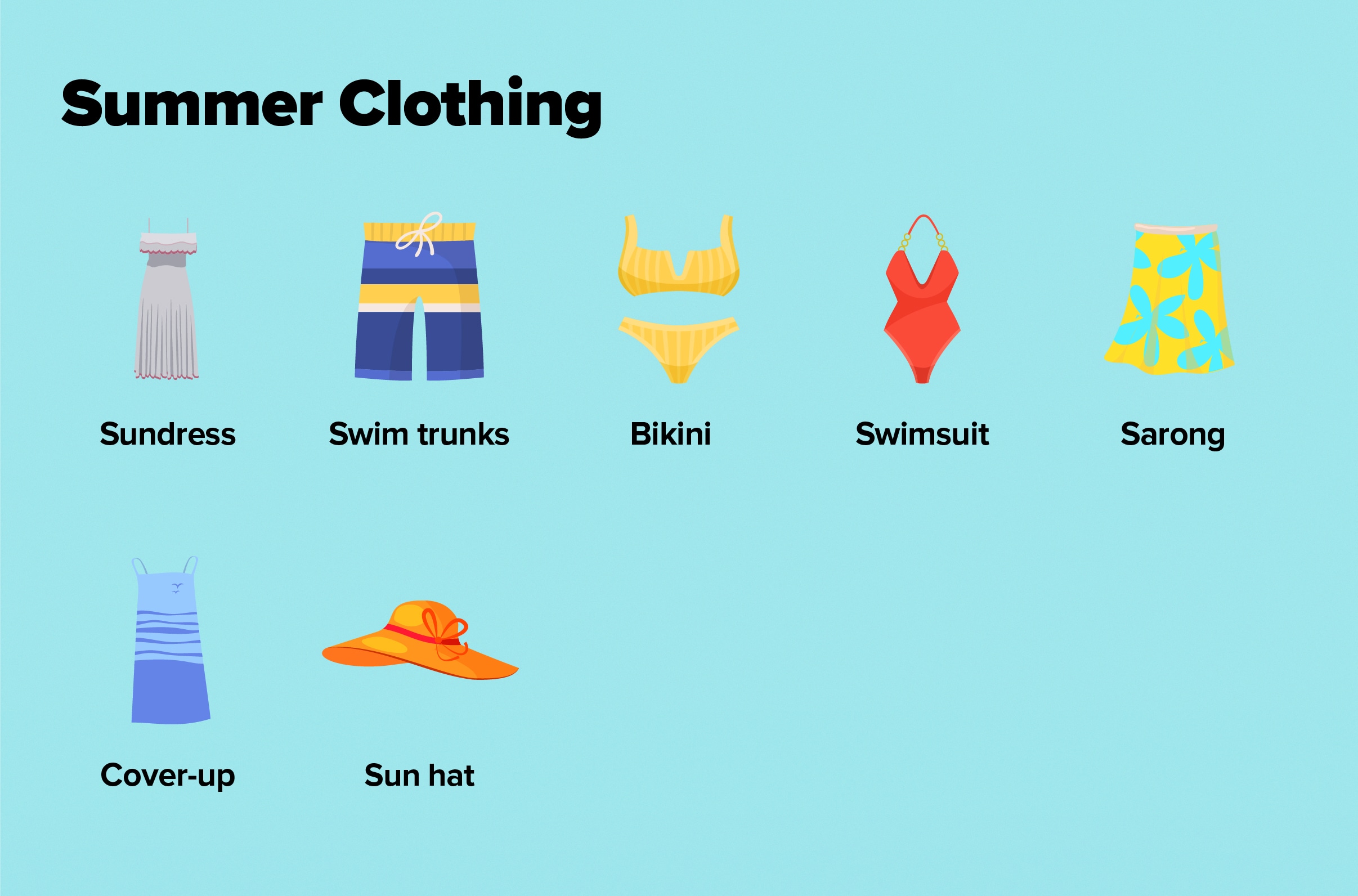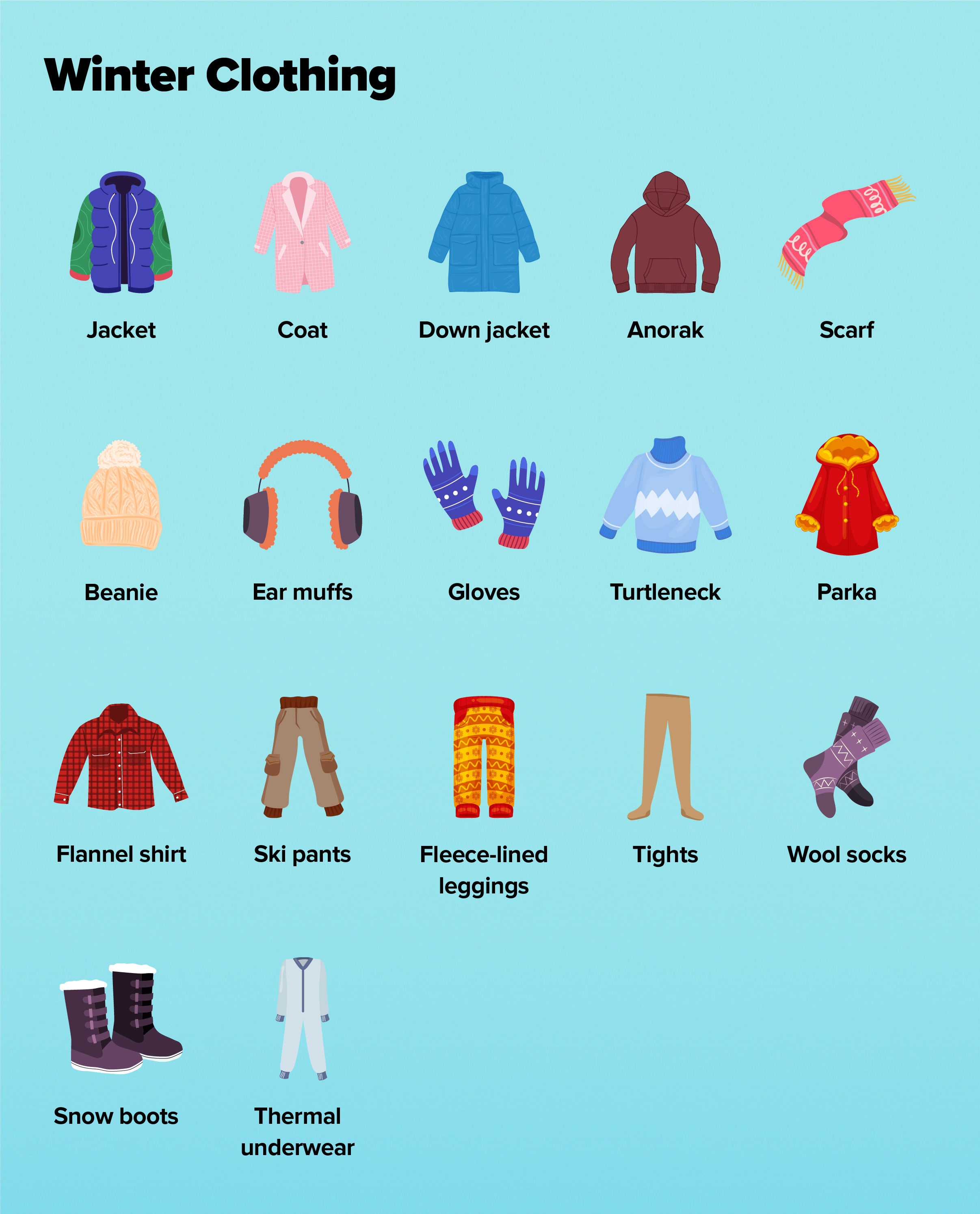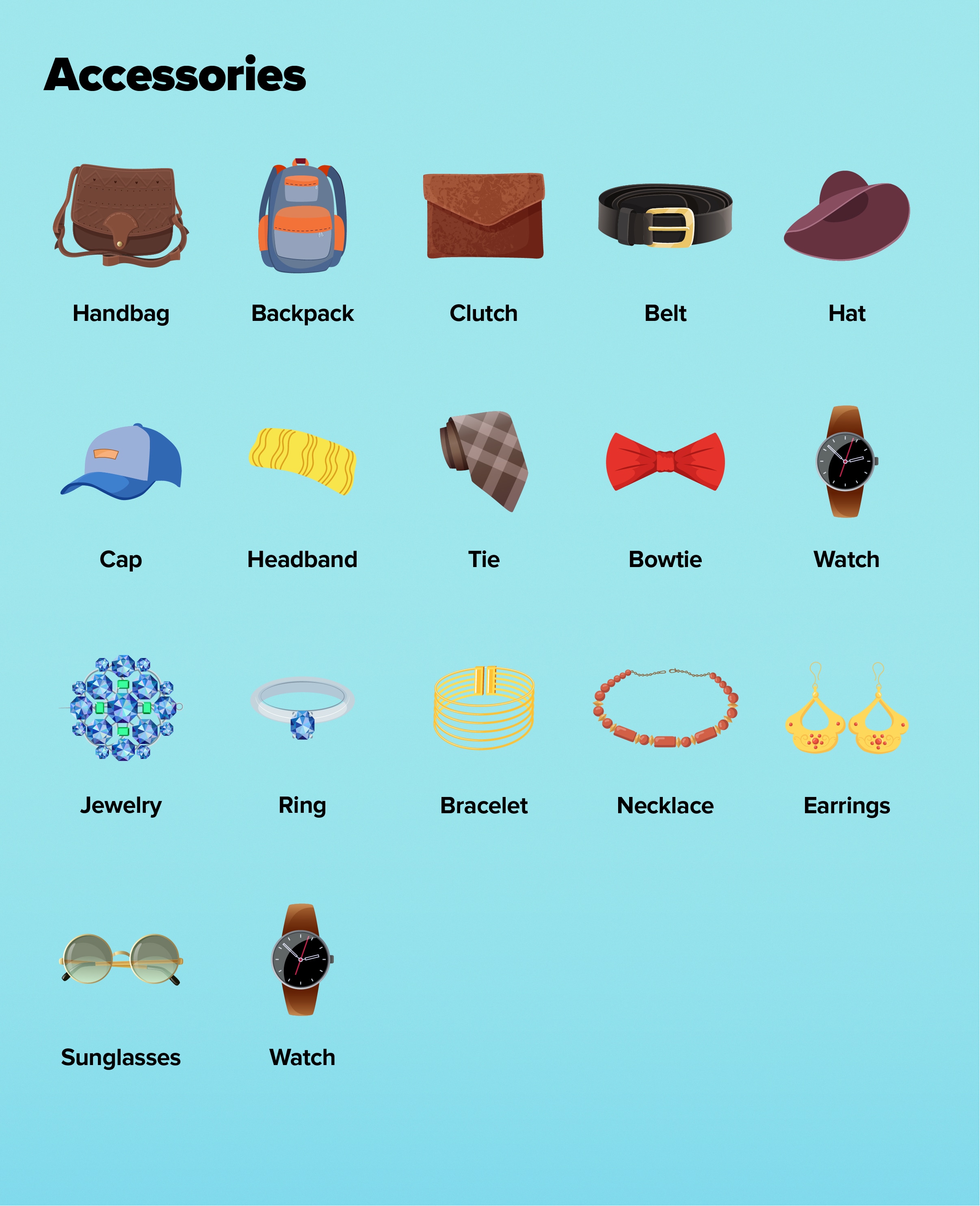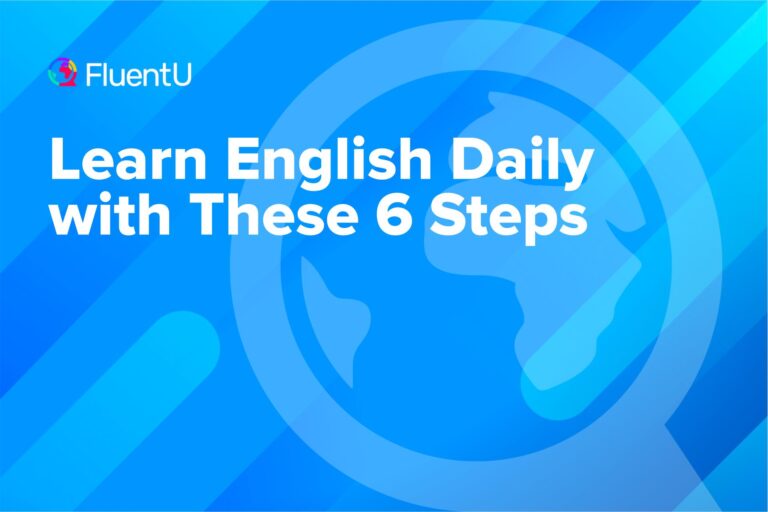Useful English Clothes Vocabulary
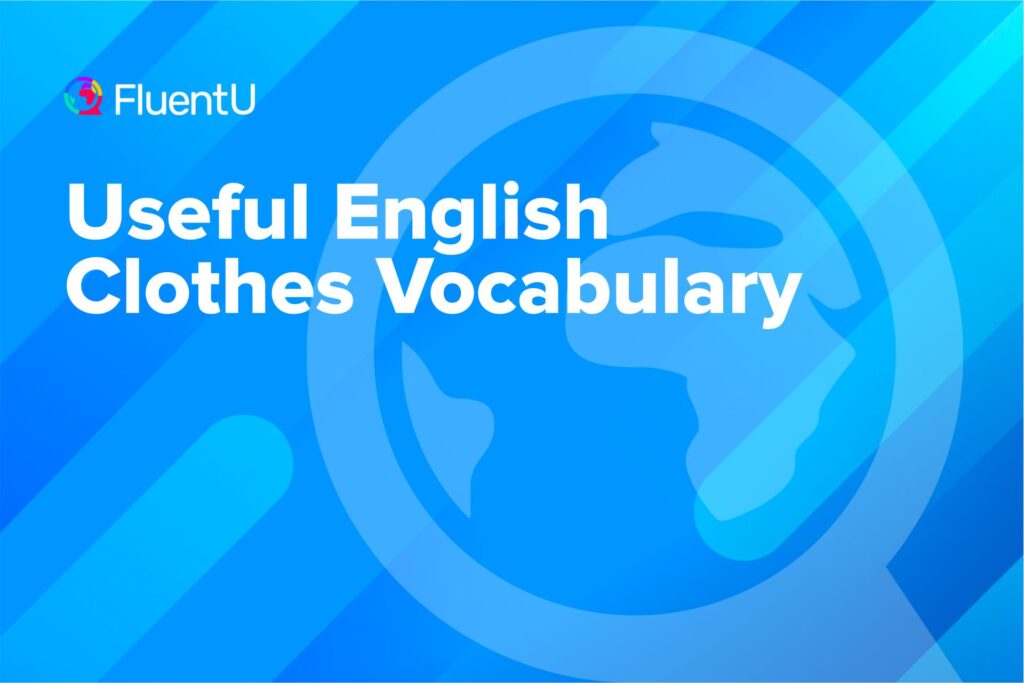
The first thing someone usually notices about you is what you’re wearing. So it’s important to know all the English clothes vocabulary you need to go shopping or have a conversation.
Discover many clothing words in English, from articles of clothing to verbs and adjectives related to fashion, all in one post.
Download: This blog post is available as a convenient and portable PDF that you can take anywhere. Click here to get a copy. (Download)
General Clothing Vocabulary
- T-shirt — A lightweight, short-sleeved shirt typically made of cotton.
- Sweater — A knitted garment worn over the upper body, usually long-sleeved.
- Hoodie — A sweatshirt or jacket with a hood and, often, a front pocket.
- Jeans — Casual trousers made of denim fabric, typically featuring pockets and belt loops.
- Pajamas — Comfortable clothing worn for sleep or lounging, usually consisting of a top and pants.
- Underwear — Clothing worn beneath outer garments, including bras, panties and boxers.
- Pants — Outer garment covering the lower half of the body, including trousers, slacks, and jeans.
- Trousers — Another term for pants, often used in formal or British English contexts.
- Slacks — Casual pants typically worn in professional or formal settings.
- Sweatpants — Loose, comfortable pants made of soft fabric, often worn for exercise or lounging.
- Track pants — Athletic pants designed for sports or casual wear, often featuring elasticated waistbands and cuffs.
- Shorts — Garments that cover only the upper part of the legs, usually worn in warm weather.
- Cargo shorts — Shorts with multiple pockets, often worn for outdoor activities or casual wear.
- Socks — Garments worn on the feet to provide warmth and comfort, often made of cotton or wool.
- Shoes — Footwear covering the foot and typically extending to the ankle or higher.
- Sneakers — Casual athletic shoes with rubber soles, designed for comfort and sports activities.
- Boots — Footwear that covers the foot and extends up the leg, often made of leather or rubber.
- Sandals — Open-toed shoes with straps or thongs, suitable for warm weather.
- Flip flops — Casual sandals consisting of a flat sole held loosely on the foot by a Y-shaped strap.
Women’s Clothing
- Blouse — A lightweight, often dressy top typically worn by women, featuring buttons or a collar.
- Cardigan — A knitted sweater or jacket that opens in the front, usually with buttons or a zipper.
- Tank top — A sleeveless shirt with thin shoulder straps and a scoop or V-shaped neckline.
- Crop top — A short, midriff-baring top, often with short sleeves or straps.
- Leggings — Tight-fitting stretch pants, usually worn by women for exercise or casual wear.
- Skirt — Garment worn around the waist, typically covering part or all of the legs.
- Dress — A one-piece garment for women or girls, typically with a skirt of any length.
- Bra — Undergarment designed to support and cover the breasts.
- Heels — Women’s shoes with a raised heel, typically more than two inches high.
- Flats — Women’s shoes with a flat sole, typically lacking a raised heel.
Men’s Clothing
- Polo shirt — A short-sleeved knit shirt with a collar and a few buttons at the neck.
- Dress shirt — A formal shirt with a collar, buttons down the front, and long sleeves, often worn with a suit.
- Blazer — A tailored jacket, similar to a suit jacket but less formal, often worn with casual or business-casual attire.
- Suit — A set of matching jacket and trousers, typically worn for formal occasions or business attire.
- Chinos — Casual cotton trousers, usually in a khaki or tan color, often worn in business-casual settings.
- Boxers — Loose-fitting underwear with an elastic waistband, typically worn by men.
- Briefs — Underwear with a snug fit and elastic waistband, offering full coverage, typically worn by men.
- Undershirt — A lightweight shirt worn under other clothing, often to absorb sweat or provide an extra layer of warmth.
Summer Clothing
- Sundress — A lightweight, sleeveless dress usually made of cotton or other breathable fabric, suitable for warm weather.
- Swim trunks — Loose-fitting shorts worn by men or boys for swimming or other water activities.
- Bikini — A two-piece swimsuit for women, typically consisting of a bra top and briefs.
- Swimsuit — A garment worn for swimming or sunbathing, usually made up of a top and bottom for women or a single piece for men.
- Sarong — A large piece of fabric worn as a skirt or dress, often wrapped around the waist and commonly used as a beach cover-up.
- Cover-up — Clothing worn over a swimsuit, typically a lightweight and loose-fitting garment such as a sarong, kaftan or tunic.
- Sun hat — A wide-brimmed hat designed to protect the face and neck from the sun’s rays.
Winter Clothing
- Jacket — A garment worn over other clothing to provide warmth or protection, typically with sleeves and a front opening.
- Coat — A longer outer garment worn for warmth or fashion, usually extending below the hips.
- Down jacket — A puffy jacket insulated with down feathers or synthetic fill, providing excellent warmth.
- Anorak — A waterproof jacket with a hood, designed to protect against wind and rain.
- Scarf — A long piece of fabric worn around the neck for warmth or fashion.
- Beanie — A close-fitting knitted cap that covers the head, often made of wool or fleece.
- Ear muffs — A pair of warm coverings worn over the ears, typically connected by a band that goes over the head.
- Gloves — Coverings for the hands, usually with separate sections for each finger.
- Turtleneck — A high-collared sweater or shirt with a close-fitting neckline that covers the neck.
- Parka — A long, hooded jacket often lined with fur or down, designed to withstand cold weather conditions.
- Flannel shirt — A shirt made of soft, warm fabric with a slightly fuzzy texture, often plaid.
- Fleece-lined leggings — Leggings with a soft, insulating fleece lining, providing extra warmth in cold weather.
- Ski pants — Waterproof, insulated pants designed for skiing or other winter sports.
- Tights — Close-fitting, stretchy leg coverings, usually worn by women and girls under skirts or dresses.
- Wool socks — Socks made of wool, known for their warmth and moisture-wicking properties.
- Snow boots — Waterproof boots with insulation, designed to keep feet warm and dry in snowy conditions.
- Thermal underwear — Undergarments made of insulating fabric, worn beneath clothing to retain body heat in cold weather.
Accessories
- Handbag — A bag carried by hand or over the shoulder, typically used to carry personal items.
- Backpack — A bag with shoulder straps, often worn on the back, used for carrying books, clothing, or other items.
- Clutch — A small, strapless purse designed to be held in the hand.
- Belt — A strap of leather or fabric worn around the waist to hold clothing in place or as a fashion accessory.
- Hat — A head covering with a brim, typically worn for protection from the sun or as a fashion accessory.
- Cap — A soft, brimless hat with a visor, usually worn for casual or athletic purposes.
- Headband — A flexible band worn around the head, often used to keep hair in place or as a fashion accessory.
- Tie — A long, narrow piece of cloth worn around the neck, typically as part of formal attire.
- Bowtie — A type of necktie consisting of a ribbon tied in a bow shape, often worn with formal attire.
- Watch — A timepiece worn on the wrist or carried in a pocket, used to tell time.
- Jewelry — Decorative items such as rings, necklaces, bracelets or earrings, typically made of precious metals and gemstones.
- Ring — A circular band worn on the finger, often as a symbol of commitment or as an accessory.
- Bracelet — A decorative band or chain worn around the wrist or arm.
- Necklace — A piece of jewelry worn around the neck, typically consisting of a chain or string with a pendant or beads.
- Earrings — Ornamental jewelry worn on the earlobes, often attached by a post or hook.
- Sunglasses — Eyewear with tinted or polarized lenses, worn to protect the eyes from sunlight or glare.
Verbs to Talk About Clothing
Of course, knowing just vocabulary words isn’t enough if you want to actually use these words in conversation. You’ll need to know how to string these words together to form sentences!
And to do that, you’ll need to know some English verbs. Here are some English verbs that are associated with clothing. You can learn how to use these verbs, and the other words in this blog post, with the FluentU program.
FluentU takes authentic videos—like music videos, movie trailers, news and inspiring talks—and turns them into personalized language learning lessons.
You can try FluentU for free for 2 weeks. Check out the website or download the iOS app or Android app.
P.S. Click here to take advantage of our current sale! (Expires at the end of this month.)

- To get dressed — To put on clothes or garments.
- To get undressed — To remove clothes or garments.
- To put on — To place clothing or accessories onto one’s body.
- To wear — To have clothing or accessories on one’s body.
- To get changed — To exchange one set of clothes for another.
- To shop — To purchase goods, typically clothes or accessories, from a store.
- To try on — To put on clothes or accessories to see how they fit or look.
- To layer — To wear multiple garments on top of each other.
- To match — To choose clothing or accessories that complement each other in style or color.
- To fold — To neatly bend or crease clothing for storage.
- To iron — To use a heated appliance to remove wrinkles from clothing.
- To do the laundry — To wash and clean clothes or other fabrics.
- To tumble dry — To dry clothes in a machine that tumbles them with hot air.
- To dry clean — To clean clothes using a solvent other than water.
- To button up — To fasten buttons on clothing.
- To zip up — To close a zipper on clothing.
- To accessorize — To add accessories to clothing or an outfit to enhance its style.
- To coordinate — To arrange clothing or accessories to match or complement each other.
- To mend — To repair or fix clothing that is damaged or torn.
- To tailor — To alter or adjust clothing for a better fit.
Adjectives to Talk About Clothing
Finally, you might want to describe the clothes you’re talking about. Learn some useful English adjectives (words used to describe nouns and pronouns) for more descriptive discussions:
- Loose — Clothing that isn’t tight-fitting and allows for freedom of movement.
- Tight — Clothing that fits closely to the body, often emphasizing its contours.
- Baggy — Loose and generously cut clothing, often intentionally oversized for a relaxed or casual look.
- Oversized — Clothing that’s larger than the wearer’s typical size, intentionally designed to be roomy or loose-fitting.
- Fitted — Clothes tailored to closely follow the contours of the body, providing a sleek and well-defined silhouette.
- Cropped — Tops or pants that are intentionally shortened, typically ending above the natural waistline or ankle.
- Stretchy — Clothing made from elastic or flexible materials that can stretch to accommodate the body’s movements.
- Cozy — Soft, warm and comfortable clothes, often worn for relaxation or lounging.
- Casual — Relaxed and informal clothing, suitable for everyday wear in non-dressy settings.
- Formal — Clothing appropriate for formal occasions or events, typically consisting of tailored suits or dresses.
- Trendy — Fashionable or currently popular clothing, often reflecting current styles or trends.
- Vintage — Clothing that is from a previous era or period, often characterized by unique or retro styles.
- Chic — Stylish, sophisticated and fashionable clothes, often with an understated elegance.
- Elegant — Clothing that is refined, tasteful and gracefully stylish, suitable for formal or special occasions.
- Bohemian (“Boho”) — A clothing style characterized by free-spirited, eclectic and unconventional elements, often using natural fabrics, earthy colors and unique accessories.
- Minimalist — Clothes characterized by simplicity, clean lines and a lack of excessive embellishment or decoration.
- Colorful — Clothing featuring a variety of vibrant hues or shades.
- Monochrome — Clothing featuring a single color or shades of a single color, typically black, white or gray.
- Patterned — Clothing adorned with decorative designs, motifs or prints.
- Plain — Simple and unadorned clothing, often lacking embellishments or patterns.
- Layered — Clothing worn in multiple layers, often for practical or aesthetic purposes, providing warmth or creating visual interest.
- Sheer — Translucent or semi-transparent fabrics in clothing tat allow partial visibility of the skin or undergarments.
- Textured — Clothing featuring surface details or patterns that create tactile interest or visual depth.
- Ripped — Intentionally distressed or torn clothes for a worn-in or edgy look.
- Tailored — Clothing that’s been custom-fitted or adjusted to suit an individual’s body shape, providing a polished and refined appearance.
You’re all dressed for success now, with all the English clothes vocabulary you’ll ever need to know for everyday conversation!
And One More Thing...
If you like learning English through movies and online media, you should also check out FluentU. FluentU lets you learn English from popular talk shows, catchy music videos and funny commercials, as you can see here:
The FluentU app and website makes it really easy to watch English videos. There are captions that are interactive. That means you can tap on any word to see an image, definition, and useful examples.
For example, when you tap on the word "searching," you see this:
Learn all the vocabulary in any video with quizzes. Swipe left or right to see more examples for the word you’re learning.

FluentU helps you learn fast with useful questions and multiple examples. Learn more.
The best part? FluentU remembers the vocabulary that you’re learning. It gives you extra practice with difficult words—and reminds you when it’s time to review what you’ve learned. You have a truly personalized experience.
Start using the FluentU website on your computer or tablet or, better yet, download the FluentU app from the iTunes or Google Play store. Click here to take advantage of our current sale! (Expires at the end of this month.)
